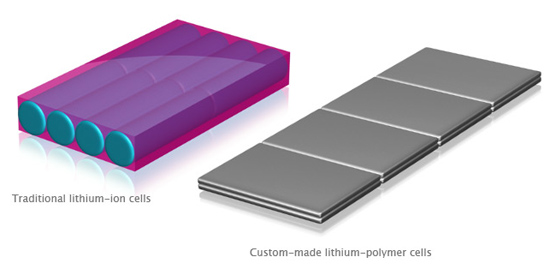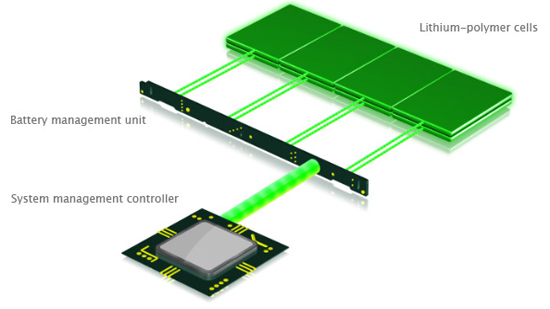Apple's 2009 MacBook Pro: Battery Life to Die For
by Anand Lal Shimpi on June 12, 2009 12:00 AM EST- Posted in
- Mac
I was so focused on the iPhone 3GS and Snow Leopard announcements from this year’s WWDC that I almost missed the gravity of the MacBook Pro announcements.
Apple announced price drops on nearly all of its laptops. The new lineup looks like this:
| MacBook | MacBook Pro 13-inch | MacBook Pro 15-inch | MacBook Pro 17-inch | |
| CPU | Core 2 Duo 2.13GHz | Core 2 Duo 2.26GHz | Core 2 Duo 2.53GHz | Core 2 Duo 2.8GHz |
| GPU | NVIDIA GeForce 9400M | NVIDIA GeForce 9400M | NVIDIA GeForce 9400M | NVIDIA GeForce 9400M + 9600M |
| Memory | 2GB DDR2 | 2GB DDR3 | 4GB DDR3 | 4GB DDR3 |
| HDD | 160GB | 160GB | 250GB | 500GB |
| Battery Life | Up to 5 hours | Up to 7 hours | Up to 7 hours | Up to 8 hours |
| Price | $999 | $1199 | $1699 | $2499 |
If you want an all aluminum body, you have to buy a MacBook Pro. There’s only a single MacBook model and it’s the white chassis that’s been around for a while now.
Apple added a 13” MacBook Pro to the lineup to fill in the gap, although it’s not clear to me whether this 13” MacBook Pro uses the same LCD panel as the old 13” aluminum MacBook or a derivative of the 15” MacBook Pro’s panel, which is superior.
 Of course there are different models within each one of these categories that you can purchase, but they are irrelevant to the discussion we’re about to have. Look at the battery life row in the table above; Apple is claiming up to 7 hours of battery on the new MacBook Pros. The old specs used to be up to 5 hours.
Of course there are different models within each one of these categories that you can purchase, but they are irrelevant to the discussion we’re about to have. Look at the battery life row in the table above; Apple is claiming up to 7 hours of battery on the new MacBook Pros. The old specs used to be up to 5 hours.
Apple did some clever work on its own here. Standard lithium ion batteries are made up of cylindrical cells, similar to AA batteries. The problem with these batteries is that they waste a lot of space within a notebook (try cramming a lot of cylinders into a box, you end up with wasted space). This wasted space translates into larger batteries than are necessary, which makes for larger notebooks.
In order to continue to drive laptop thinness down, Apple started experimenting with using custom lithium polymer batteries instead of the industry standard lithium ion parts. Lithium polymer cells aren’t made of cylindrical cells (they’re rectangular), so there’s no wasted space. Not only does this make the batteries more compact, but it also gives you greater capacity since you’re using all available chassis volume for the battery.

Makes sense. Courtesy, Apple.
Apple also found that it was wasting space in the removable enclosure for the batteries as well, so its lithium polymer offerings are no longer user removable. I suspect this part of the equation has more to do with cutting costs than saving space though.
Apple first used this lithium polymer battery technology in its MacBook Air. It gave Apple a very thin battery that allowed it to create the MacBook Air’s sweet form factor. Then came the new 17” MacBook Pro, without a removable battery. Apple claimed that this battery would last for five years before it needed replacing and resulted in up to an 8 hour battery life.

The extended life is supposedly due to an on-battery sensor that communicates with the system's management controller that can dynamically sense the needs of each lithium polymer cell and feed that info back to the charging circuitry. The result is slight variations in charging current designed to optimally charge each and every cell; apparently reducing wasted charge cycles significantly. Apple claims that most cells will hit 80% of their life after 200 - 300 charge cycles, but its special lithium polymer batteries will hit the 80% mark after as many as 1000 charge cycles. Apple claims its unique battery chemistry and microprocessor managed charging (Adaptive Charging) is responsible for these gains but it’s a difficult statement to prove; we’ll have to wait and see what happens after a few years of use.










113 Comments
View All Comments
BushLin - Tuesday, June 16, 2009 - link
Right now, you may not care that your battery isn't removable. After 13 months, when it's failed and Apple want to charge you the price of a netbook to take it in and replace it, you may do.Johnmcl7 - Sunday, June 14, 2009 - link
It's been done already long before Apple (as with most of their innovations) plenty of companies have produced laptops with extremely long batterylife but without fixing the battery.Apple's solution is nothing clever as all they've done is sacrifice the removeable battery, I just really hope other companies don't do this as well as has been happening in the mp3 player market particularly with Sandisk.
iwodo - Saturday, June 13, 2009 - link
From an environmental standpoint, having battery built in means you will have to bring the Notebook back to Apple to buy a new battery. This would means your old battery is properly deposited.I am surely there will be third party, or possibly even apple would make an External battery for all Macbook that plugs into the power plug.
djuero - Saturday, July 4, 2009 - link
Those products (external batteries) are available from different companies already...sendai - Sunday, June 14, 2009 - link
Yup, they've been around for ages, though I'd say Apple have energised the market for them:http://www.batterygeek.net/SearchResults.asp?Cat=7...">http://www.batterygeek.net/SearchResults.asp?Cat=7...
http://www.hyperdrive.com/HyperMac-External-MacBoo...">http://www.hyperdrive.com/HyperMac-External-MacBoo...
http://www.quickertek.com/products/macbook_air_cha...">http://www.quickertek.com/products/macbook_air_cha...
iwodo - Sunday, June 14, 2009 - link
Now it has been proven that there are massive amount of external power out there. I wonder why the need for a removable 2nd battery?With Internal battery, you get more space, longer battery, and more environmental friendly. Why would you need a 2nd battery when you can do the same with external power?
PlasmaBomb - Saturday, June 13, 2009 - link
That is an interesting thought. Wonder how feasible it is...Pandamonium - Saturday, June 13, 2009 - link
I'm looking at the specs and can't help but think Apple moved the 13" unibody MB into their MBP line and added a price cut to boot. My wife just got a "free" 13" unibody. (Her MB was a legit lemon, and after 5 or 6 Applecare repairs, the store just gave her a replacement) Anyway, the specs of her replacement are in line with what I see here for the MBP version. We don't have the machine with us to compare removable batteries, but we'll definitely do that after our honeymoon.gcor - Saturday, June 13, 2009 - link
For a truly portable machine for getting stuff done, wouldn't an 11" netbook be a better option than a MacBook?Right now I don't think any of the MacBooks stack up as well as machines like the Acer Aspire 11.6".
11-12 inch netbooks seems to; tick all my must haves (see below), have excellent weight, and great form factor. While I would prefer an OS-X machine, MacBooks that meet my must haves are twice the weight and 4 times the price of a comparable netbook.
For my needs at university. I've settled on the following requirements:
Absolute must haves are:
- Display sufficient to view and skim read multi-column research papers:
>= 1200x800
>= 11"
- Suffient performance to:
- quickly flick thourgh PDFs and powerpoints
- create and edit files using MS Office
- surf the web
- >= 8 hours battery for the functions above
- fullsize laptop keyboard
- OS-X or Windows (no Linux due to MS Office:-( )
- WiFi, tackpad, >=20Gb free disk, USB, speakers.
In addition, my nice to haves are:
- OS-X over Windows
- Light
- Thin
- Low price
iwodo - Saturday, June 13, 2009 - link
Snow Leopard were suppose to speed things up, May be it will bring some even greater battery life. May be a retest once SL is out?I can imagine future Macbook Pro having 12 hours battery life if it has an SSD and OLED display.
Apple could surely make an interesting Netbook or Cheaper Macbook Air with Dual Core Atom with these Battery inside.